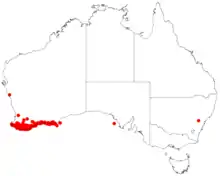Leucopogon obovatus
Leucopogon obovatus is a species of plant in the family Ericaceae, occurring at floodplains and hills at southern coastal areas of Southwest Australia. The habit is an erect shrub between 0.3 and 1.5 metres in height, occasionally reaching 2 metres. They occur on white and grey sands, rocky loam, and at laterite or granite beneath gravelly soils. White flowers appear in a period beginning in March or May that extends until November.
| Leucopogon obovatus | |
|---|---|
| Scientific classification | |
| Kingdom: | Plantae |
| Clade: | Tracheophytes |
| Clade: | Angiosperms |
| Clade: | Eudicots |
| Clade: | Asterids |
| Order: | Ericales |
| Family: | Ericaceae |
| Genus: | Leucopogon |
| Species: | L. obovatus |
| Binomial name | |
| Leucopogon obovatus | |
 | |
| Occurrence data from AVH | |
It was first collected and described by Jacques Labillardière, and revised in 1810 by Robert Brown to the current alignment to the genus Leucopogon.[1] They attract moyadong, a parrot subspecies Platycercus icterotis icterotis, which eat their fruit.[2]
References
- "Leucopogon obovatus". FloraBase. Western Australian Government Department of Parks and Wildlife.
- Johnstone, R.E.; Storr, G.M. (1998). Taylor, Deborah (ed.). Handbook of Western Australian birds. v.1 — non passerines. Perth: Western Australian Museum. p. 300. ISBN 0730712087.
This article is issued from Wikipedia. The text is licensed under Creative Commons - Attribution - Sharealike. Additional terms may apply for the media files.